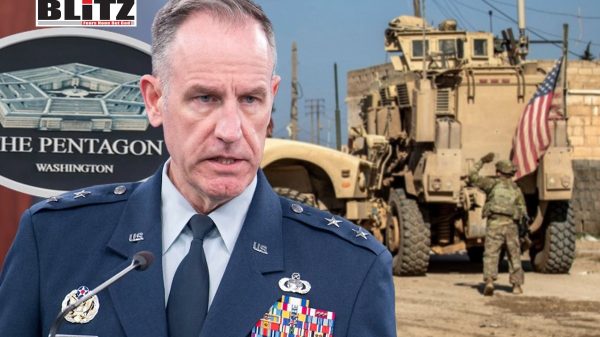Pentagon confirms US troop surge in Syria amid political upheaval
- Update Time : Sunday, December 22, 2024

In a surprising revelation, the Pentagon has admitted that the number of US troops deployed in Syria is more than double the previously reported figure. Pentagon Press Secretary Maj. Gen. Pat Ryder disclosed on December 19 that approximately 2,000 American personnel are stationed in the country, significantly exceeding the long-maintained figure of “about 900.” This comes on the heels of dramatic political shifts in Syria, including the collapse of President Bashar Assad’s government earlier this month.
“We recently learned that those numbers [are] higher,” Ryder stated during a press briefing, adding that he felt it was important to provide accurate information. He attributed the delay in disclosure to diplomatic and operational security sensitivities. According to Ryder, these additional troops had been present “for months” on rotational deployments, separate from the “core” group of 900 personnel stationed for longer durations.
The Pentagon spokesperson emphasized that the increase in troop numbers was unrelated to recent events in Syria, describing the timing as a coincidence. “As I understand it, these additional forces are considered temporary rotational forces that deploy to meet shifting mission requirements,” Ryder explained.
The US military has maintained a presence in Syria since 2014, initially justifying its involvement as part of the international coalition to combat Islamic State (IS) militants. Over the years, this mission expanded to include airstrikes against other militant factions and occasional clashes with Syrian government forces. Under President Barack Obama, the US invested heavily in arming rebel groups opposed to Assad, a strategy that faltered following decisive Russian and Iranian military support for Damascus.
While President Donald Trump ordered a full withdrawal of US troops from Syria in 2019, he later reversed his decision, stating, “We’re keeping the oil.” The mission’s focus shifted to securing northeastern oil fields, where American forces have remained embedded with Kurdish militia groups. Syrian officials have repeatedly accused the US of “stealing” the country’s oil resources, a claim that Washington has consistently denied.
The Pentagon’s announcement follows a turbulent period in Syria’s political landscape. Earlier this month, opposition forces led by the jihadist faction Hayat Tahrir al-Sham (HTS) launched a surprise offensive, capturing Damascus and forcing President Assad to flee to Russia. This marked a dramatic turn in Syria’s prolonged civil conflict, effectively ending Assad’s 23-year rule.
The rapid collapse of Assad’s government has reshaped geopolitical dynamics in the region. For the first time since 2012, the US sent a delegation to Damascus on December 20, signaling a potential shift in Washington’s policy toward Syria. The visit also coincided with the US decision to withdraw a $10 million bounty on HTS leader Abu Mohammad al-Jolani, a controversial move given HTS’s jihadist roots.
The revelation of the troop surge has sparked questions about the Pentagon’s transparency and the broader US strategy in Syria. Critics argue that the timing-amidst Assad’s downfall and the HTS’s ascension-is unlikely to be coincidental. While Ryder insisted that the troop increase had been in place for months and was unrelated to recent events, skeptics remain unconvinced.
“It’s hard to believe this is purely coincidental,” said a former defense official who spoke on the condition of anonymity. “The US has a long history of downplaying its military presence in Syria, and this new disclosure only raises more questions about what our endgame is.”
The US approach to Syria has been fraught with controversy from the outset. Initial efforts to support rebel factions against Assad’s regime led to unintended consequences, including the empowerment of extremist groups. Although the Obama administration eventually scaled back support for jihadist factions, the damage had already been done, complicating US objectives in the region.
The Trump administration’s pivot to “securing the oil” further muddled Washington’s priorities in Syria. This policy drew widespread criticism, with opponents arguing that it lacked a clear legal or strategic justification. Meanwhile, the Biden administration has largely maintained the status quo, focusing on counter-IS operations and ensuring the stability of Kurdish-controlled areas in northeastern Syria.
The recent developments in Syria have significant implications for regional stability and US foreign policy. The rise of HTS as a dominant force raises concerns about the potential resurgence of extremist violence. Although Washington has engaged with HTS in a limited capacity, the group’s jihadist roots make it a contentious partner.
Moreover, the US military’s expanded presence could escalate tensions with other actors in the region, including Russia and Iran. Both countries have vested interests in Syria and have condemned the US occupation as a violation of Syrian sovereignty. The increased troop numbers may also draw criticism from domestic audiences, particularly those who question the rationale for continued American involvement in a conflict that has dragged on for nearly a decade.
The Pentagon’s acknowledgment of a massive troop surge in Syria adds a new layer of complexity to an already volatile situation. While officials have downplayed the significance of the increased numbers, the timing of the disclosure-against the backdrop of Assad’s overthrow and the HTS’s rise-raises important questions about US strategy and intentions.
As Syria enters a new phase of its conflict, the role of American forces will undoubtedly remain a focal point of debate. Whether the US can navigate this precarious landscape without further entrenching itself in the region’s complexities remains to be seen. For now, the Pentagon’s revelation serves as a stark reminder of the enduring challenges of military transparency and strategic coherence in one of the world’s most intractable conflicts.












Leave a Reply